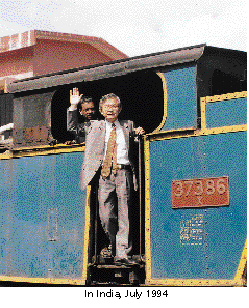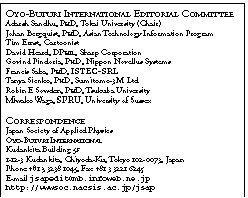Interview
Professor Kunio Tada, the President of The Japan Society of Applied Physics
Professor Tada was born in Tokyo. He received his doctorate from the University of Tokyo in 1965, after which he joined the Faculty of Engineering as a lecturer and became a full professor in 1981, and from 1972 to 1973 he was a visiting scholar at the University of Pennsylvania. An expert on semiconductor devices, he is currently conducting research on semiconductor photonic devices. He was awarded the Hattori-Hoko Prize in 1978 for his contribution to the development of the optical directional coupler modulator/switch. Professor Tada is President of the Japan Society of Applied Physics ( jsap ) and is a Fellow of the Institute of Electrical and Electronics Engineers ( IEEE ).
To commemorate the launch of Oyo-Buturi International ( OBI ), we have asked Professor Tada to talk to us about the JSAP , science and education.
OBI: Can you tell us something about the international activities being pursued and planned by the JSAP ?
Professor Tada: The JSAP wants to be a full and active member of the international scientific community and we have already initiated a number of projects in order to achieve this goal. For example, we have established mutual cooperation agreements with five academic societies overseas where the members of the overseas societies are allowed the same privileges as JSAP members, such as JSAP member rates for journals and participation in conferences, and vice versa. Details of the agreements can be found in the JSAP journal and also our home page, which is written in both Japanese 1 and English2. To give an overview, we have cooperation agreements with: The American Physical Society (APS), European Physical Society (EPS), Institute of Physics (IOP), Optical Society of America (OSA), and Electron Devices Society (EDS) of the IEEE. We are now in the process of setting up an agreement with the Lasers and Electro-Optics Society (LEOS) of the IEEE which we hope to sign towards the end of 1997. We would like to encourage overseas scientists to take part in the two major conferences held by jsap in the spring and autumn of each year where English abstracts and presentations are most welcome. Even though this jsap monthly journal is written in Japanese, the titles and abstracts of the papers are written in English. Our home page also has articles and reviews in English. We hope that this new Oyo Buturi International section will be useful as a source of information for the members of the international community who are interested in scientific and cultural activities in Japan. We also hope that the Japanese Journal of Applied Physics and Optical Review, both published in English, will make an even greater contribution to the international community.
OBI: Thank you for that review of JSAP activities. Now let's move on to the topic of education and science.
OBI: What do you think about the proposal to introduce the Tobikyu 3 system for physics high school students?
Professor Tada: I do not think that it is necessary. Bright students can manage without this sort of special treatment. Instead, I think that high school and undergraduate students should be encouraged to study a wider range of subjects such as arts, languages and social sciences, and not confine their ideas to such a limited field at such a young age. But at the graduate school level I think that it would be reasonable to let science doctoral students who have excelled in their field to graduate after 3 to 4 years instead of the present 5 years that it normally takes to complete the course in Japan. However, only a few students have completed their research in 4 years at the Graduate School of Engineering of this University since this system started only recently.

OBI: Let us look to the future and the 21 st century. What inventions or ideas would you like to see in the next century?
Professor Tada: I think that there are a lot of problems that will need addressing including energy, raw materials, food supply, environmental pollution, and population growth. The solutions will depend on peoples' politics, culture, religion and so on. Inventions to solve these problems would be most welcome. These are difficult problems and I hope that we can find solutions that will prevent a major human crisis and that science and technology will make significant contributions to finding these solutions.
OBI: I would like to ask your views about science and children. How do you think we should encourage young children to take an interest in science?
Professor Tada: I think the first step would be to encourage them to make things and break things and build things by using their own hands.
OBI: On a similar theme, do you have any suggestions for stopping the tide of young people moving away from science and technology?
Professor Tada: I think there would be more interest in science and technology as a profession if industry paid better salaries. But it is related to supply and demand and you will probably agree that interest in science and technology as a career increases during an economic recession
OBI: Now on a slightly lighter note, can you tell us a little about your hobbies and past-times?
Professor Tada: One of my hobbies is travelling. I have visited more than 35 countries and I particularly enjoy travelling by train. I am a "railway enthusiast". I find that travelling by train is the best way to experience a country at first hand. I like steam locomotives the most of all. They are used mainly in theme parks by tourists in Europe and usa but in China, and of course India where I have been three times, they are still used as regular transport. I also enjoy reading books about the history and geography of countries.
OBI: What kind of novels do you like most?
Professor Tada:
I used to enjoy reading books by Sato Haruo such as
Den-en No Y utsu.
utsu.
OBI: Again changing the subject, if you were asked to host some overseas visitors coming to Japan for the first time, where would you take them to show them a representative aspect of modern Japan?
Professor Tada:
I would first take them to T ky
ky Station. This is perhaps the busiest station in the world where the trains carry millions of people every day to and from all over Japan efficiently and safely. This could be seen to represent modern Japan and its ability to organize. The sight should give a first-time visitor a feeling of modern Japan.
Station. This is perhaps the busiest station in the world where the trains carry millions of people every day to and from all over Japan efficiently and safely. This could be seen to represent modern Japan and its ability to organize. The sight should give a first-time visitor a feeling of modern Japan.
OBI: And finally, I would like you to consider the following scenario. Assuming that you had a plentiful supply of food, adequate shelter and clothing, what three things would you like to have with you if you were stranded on a desert island?
Professor Tada: Boredom would be the main problem. So the three things would be a comprehensive encyclopedia, a television or radio and the final choice would be a set of materials/tools for making model trains. That would be enough to keep me occupied until a ship passed by!
References
1. The JSAP Japanese home page: http://wwwsoc.nacsis.ac.jp/jsap
2. The JSAP English home page: http://wwwsoc.nacsis.ac.jp/jsap/english/
3. The Japanese term tobikyu refers to a proposed system of education that would allow extremely able high school and university students studying physics to graduate one year earlier than the normal. This subject is a source of heated debate in Japan.
